Bradford and Shelf Tramway Company
History
The Bradford and Shelf Tramway Company, which was exclusively a steam-operated concern, commenced services over Bradford Corporation's newly built line along Manchester Rd on the 8th September 1884. At this time, although municipalities were allowed to build and own tramways, they were prevented from operating them, except in the unlikely event that no lessee could be found, as had been the case at nearby Huddersfield the previous year. The corporation had assumed that the operator of its existing tramways (the Bradford Tramways and Omnibus Company) would take on the lease, but found the company either unwilling or unable to do so, a decision which the latter probably came to rue, given that it turned out to be an extremely profitable one.
The initial line, which was 1.9 miles long, ran from the Town Hall southwards along Manchester Rd to Rooley Lane in Bankfoot. Following pressure from North Bierley Local Board, whose boundary was just a short distance further southwards, powers were obtained in 1885 to extend the line a further 2.7 miles, initially to Odsal, then southwestwards along Halifax Rd to Shelf. The new line was opened in two sections, the first to Buttershaw — the boundary between North Bierley and Shelf Local Boards — opening on the 11th June 1886, and the remainder, to the Bottomley Arms in Shelf on the 27th July 1886. The track in Bradford was owned by Bradford Corporation, that in North Bierley by the Local Board, who exercised their option to purchase it on completion (leasing it back to the company), and the remainder by the Shelf Tramway Company, a shell company wholly owned by the B&STCo.
A further extension was opened on the 23rd February 1892; this ran southwards along Huddersfield Rd from a junction with the existing line at Odsal to Wyke, and was wholly within the territory of North Bierley Local Board. As happened with the B&STCo's Shelf line, the Local Board once again purchased the line on completion, leasing it back to the tramway company to operate. This new line was the final one built, and brought the length of tramway operated by the company to its maximum, 7.54 miles. Although the city centre terminus was at the Town Hall, the lines operated by the B&STCo were not connected to those of the BT&OCo.
The tramway company was a highly profitable undertaking, paying its rent to the two local authorities, and having plenty left over for renewals and reserves, as well as to pay handsome dividends to its shareholders. Although the company's leases did not expire until 1903, the writing was clearly on the wall well before this, the corporation opening the first line of its ambitious new electric tramway system on the 30th July 1898. Once the new routes had been built, the corporation's attention would inevitably turn towards the existing horse and steam-operated lines, which it could either allow the lessees to keep running until 1903, or terminate the leases earlier. The corporation's desire to press on with its grand scheme was no doubt reinforced by the profits being made by the B&STCo, which to add insult to injury, were by and large over the corporation's own tracks (including those of North Bierley Local Board, which was absorbed by Bradford in 1899).
The corporation took over operation of the tramway on the 1st February 1902, compensating the company accordingly for the termination of its lease, and using engines and trailers leased from the company. Conversion to electric traction proceeded apace, the last steam service over the Wyke line running on the 3rd May 1902, and over the Shelf line (between Buttershaw and Shelf) on the 1st April 1903.
Uniforms
Photographs of the Bradford and Shelf Tramway Company have survived in reasonable numbers, so it is possible to state with a reasonable degree of confidence what attire was worn. In common with the majority of UK steam-operated tramways, drivers wore very similar clothing to their railway counterparts, namely, heavy cotton trousers and jackets, often light in colour, along with heavy-cotton or flat caps. No badges or insignia were worn on either the jackets or the caps.
Although many of the photographs are difficult to date with precision, it seems likely that conductors initially wore self-purchased jackets (a fairly common policy of horse and steam tramway companies), as a variety of styles are in evidence; the only company-issued item seems to have been a kepi-style cap, which had a glossy peak, but no obvious cap badge. It is however possible that the caps bore an embroidered badge that does not show up well on photographs.
Later in the tramway's life (the early 1900s?), it would appear that the company began to issue conductors with uniform jackets, as photos show them wearing double-breasted, 'lancer-style' jackets with five pairs of buttons (narrowing from top to bottom) and upright collars. It is currently unclear if these jackets bore badges of any kind.
Photographs of inspectors appear not to have survived, so it is impossible to say what they wore, or indeed, if the company employed them at all.
Further reading
For a history of Bradford's tramways, see: 'Bradford Corporation Tramways' by J S King; Venture Publications (1999). A more detailed account of Bradford's steam trams can be found in 'A History of the British Steam Tram - Volume 2' by David Gladwin; Adam Gordon Publishing (2006).
Images
Steam tram drivers and conductors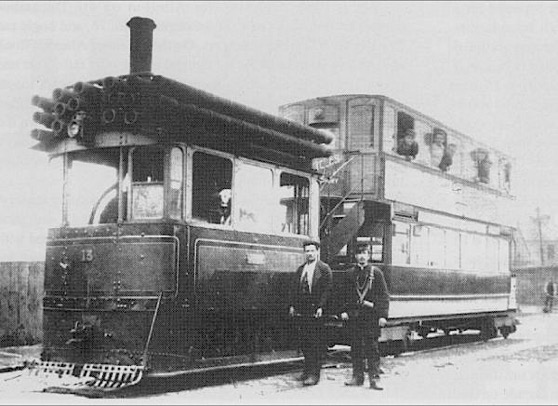
A driver and a conductor with Steam Tram No 13 — photo undated, but given the good condition, probably taken not too long after 1893 when it was built. Photo courtesy of the Tramways and Light Railway Society, with thanks to David Voice.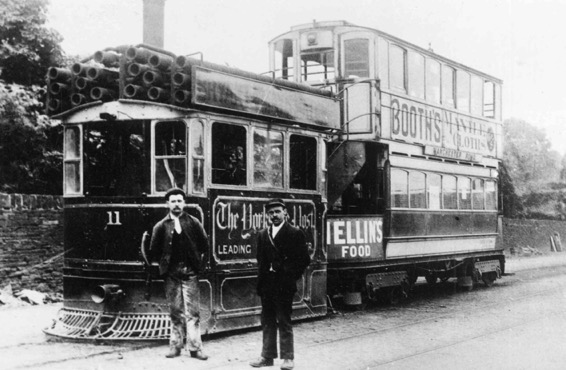
A nice sharp image of Steam Tram No 11 (a Thomas Green Product delivered in 1892) and an unidentified trailer. Both are in relatively good condition, so the date is probably 1893 or 1894. Photo courtesy of David Gladwin, with thanks to Trevor Preece.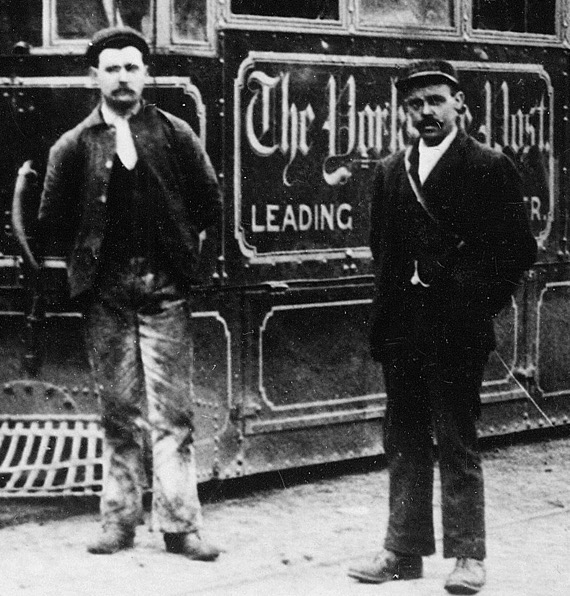
A blow-up of the above photo showing the driver and conductor. The former is wearing typical footplate attire and a flat cap, whilst the latter would appear to have a self-purchased jacket and waistcoat, along with a company-issued kepi. The cap does not bear a reflective badge, though there is a hint of markings, suggestive of an embroidered badge.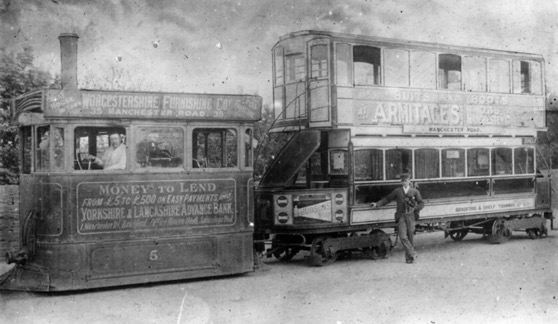
Steam Tram No 5 and Trailer No 7 at the terminus in Shelf — photo undated, but definitely taken no earlier than 1893 when Trailer No 7 was built. Photo courtesy of the Tramways and Light Railway Society, with thanks to David Voice.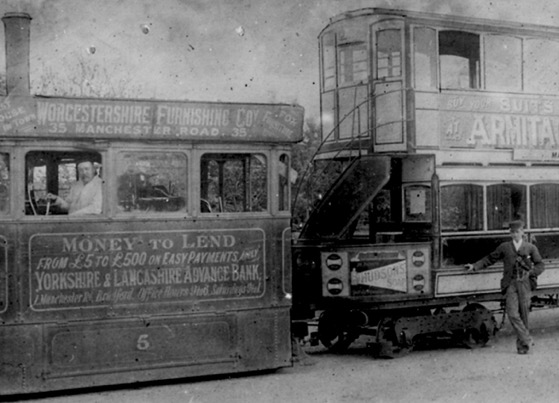
A blow-up of the above photo showing the driver and conductor, the former wearing a railway footplate-style cotton jacket, the latter in what would appear to be wearing a frock-style coat (probably self-purchased), along with a kepi-style cap (almost certainly issued by the company). Photo courtesy of the Tramways and Light Railway Society, with thanks to David Voice.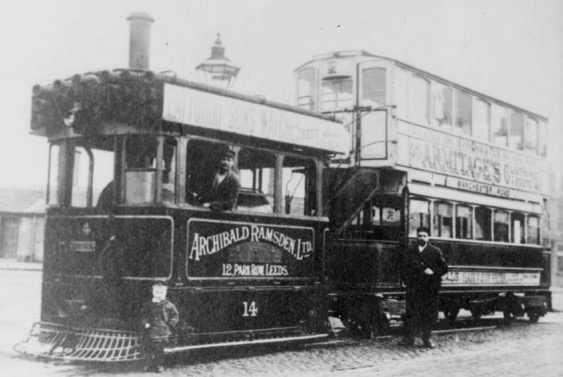
Steam Tram No 14 (built in 1893) at the Bankfoot terminus — photo undated, but given the good condition of the engine, probably taken not too long after delivery. With thanks to the National Tramway Museum. 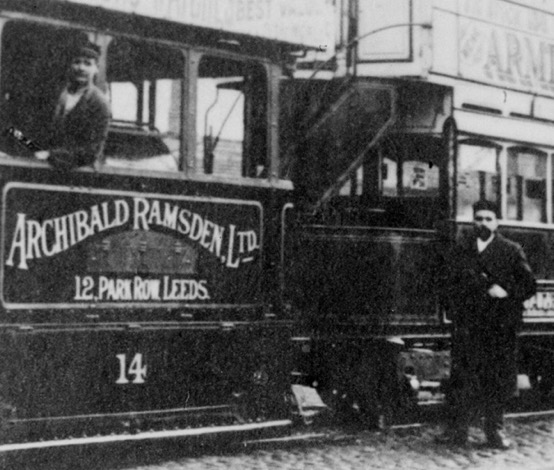
A blow-up of the above photo showing the crew.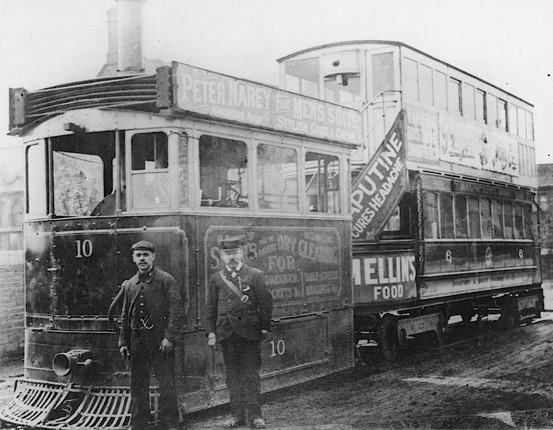
The driver and conductor of Steam Tram No 10 (a Thomas Green product delivered in 1886) stand with their charge and what appears to be a recently outshopped Trailer No 6 — photo undated, but possibly taken in the mid-to-late 1890s. Author's Collection.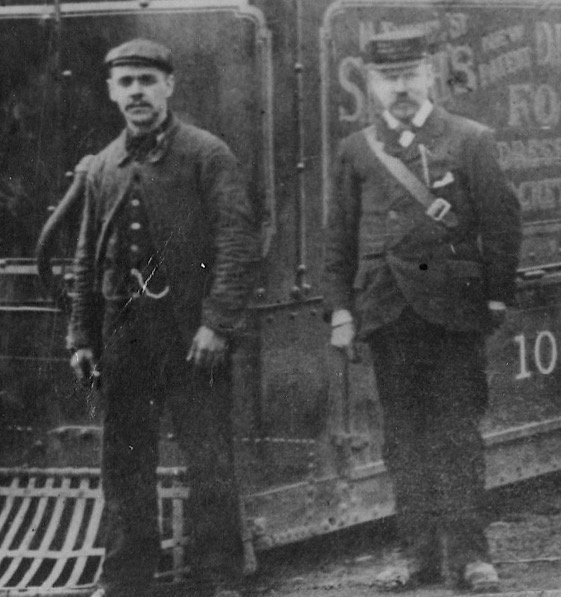
A blow-up of the above photo showing the crew. It is unclear whether the conductor's cap bears a cap badge; although there is a hint of something reflective, this could simply be a trick of the light. 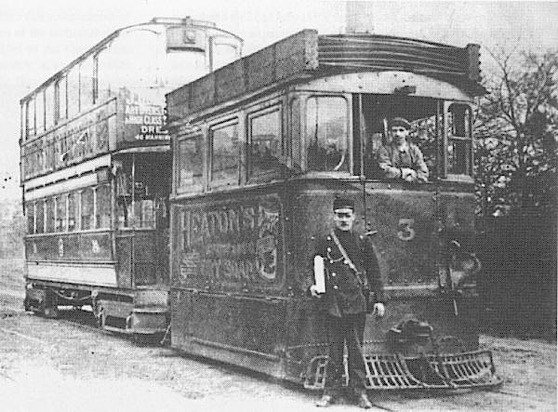
A uniformed conductor and flat-capped driver with a rather care-worn Steam Tram No 3 — photo undated, but probably taken around the turn of the century. With thanks to the late Stanley King.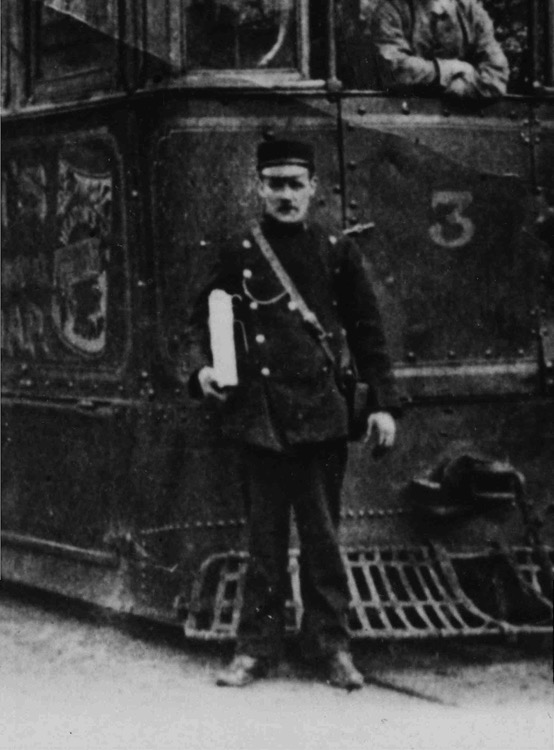
A blow-up of the above photo, which clearly shows that the conductor is wearing a 'lancer-style' jacket with upright collars, along with what would appear to be an unmarked kepi-style cap.